
Liguria is a region of north-western Italy; its capital is Genoa. Its territory is crossed by the Alps and the Apennines mountain range and is roughly coextensive with the former territory of the Republic of Genoa. Liguria is bordered by France to the west, Piedmont to the north, and Emilia-Romagna and Tuscany to the east. It rests on the Ligurian Sea, and has a population of 1,557,533. The region is part of the Alps–Mediterranean Euroregion.
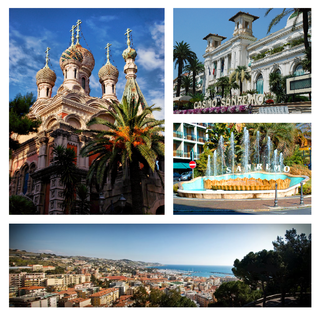
Sanremo or San Remo is a comune (municipality) on the Mediterranean coast of Liguria, in northwestern Italy. Founded in Roman times, it has a population of 55,000, and is known as a tourist destination on the Italian Riviera. It hosts numerous cultural events, such as the Sanremo Music Festival and the Milan–San Remo cycling classic.

The French Riviera, known in French as the Côte d'Azur, is the Mediterranean coastline of the southeast corner of France. There is no official boundary, but it is considered to be the coastal area of the Alpes-Maritimes department, extending from the rock formation Massif de l'Esterel to Menton, at the France–Italy border, although some other sources place the western boundary further west around Saint-Tropez or even Toulon. The coast is entirely within the Alpes-Maritimes, a department within Provence-Alpes-Côte d'Azur region of France. The Principality of Monaco is a semi-enclave within the region, surrounded on three sides by France and fronting the Mediterranean. The French Riviera contains the seaside resorts of Cap-d'Ail, Beaulieu-sur-Mer, Saint-Jean-Cap-Ferrat, Villefranche-sur-Mer, Antibes, Juan-les-Pins, Cannes, and Theoule-sur-Mer.
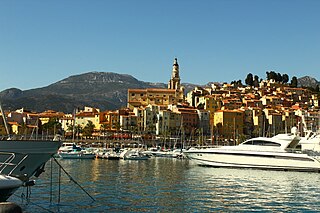
Menton is a commune in the Alpes-Maritimes department in the Provence-Alpes-Côte d'Azur region on the French Riviera, close to the Italian border.
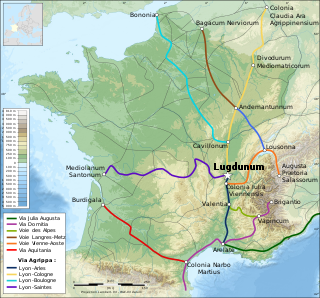
The Via Aquitania was a Roman road created in 118 BC in the Roman province of Gaul. It started at Narbonne, where it connected to the Via Domitia. It then went toward the Atlantic Ocean, via Toulouse and Bordeaux, covering approximately 400 kilometres (250 mi).

The province of Imperia is a mountainous and hilly province in the Liguria region of Italy, situated between France to the north and the west, and the Ligurian Sea, an arm of the Mediterranean Sea to the south. Its capital is the city of Imperia.

The Via Aurelia is a Roman road in Italy constructed in approximately 241 BC. The project was undertaken by Gaius Aurelius Cotta, who at that time was censor. Cotta had a history of building roads for Rome, as he had overseen the construction of a military road in Sicily connecting Agrigentum and Panormus.
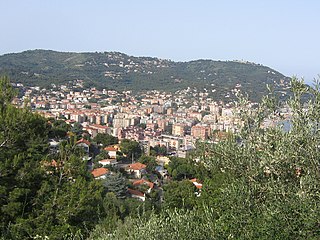
Andora or Marina di Andora is a town on the Italian Riviera in the region of Liguria, included in the province of Savona.
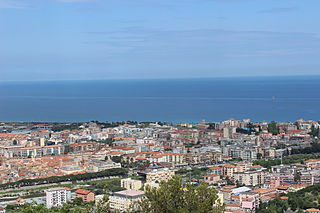
Albenga is a city and comune situated on the Gulf of Genoa on the Italian Riviera in the Province of Savona in Liguria, northern Italy.

The Via Postumia was an ancient military Roman road of northern Italy constructed in 148 BC by the consul Spurius Postumius Albinus Magnus.

Ceva, the ancient Ceba, is a small Italian town in the province of Cuneo, region of Piedmont, 49 kilometres (30 mi) east of Cuneo. It lies on the right bank of the Tanaro on a wedge of land between that river and the Cevetta stream.
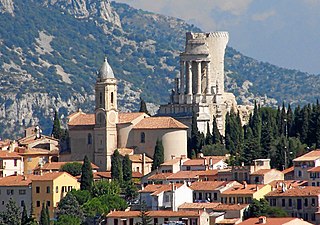
La Turbie is a commune in the Alpes-Maritimes department in southeastern France.

The Tropaeum Alpium, is a Roman trophy (tropaeum) celebrating the emperor Augustus's decisive victory over the tribes who populated the Alps. The monument's ruins are in La Turbie (France), a few kilometers from the Principality of Monaco.

The Genova-Ventimiglia railway runs along the coast of the Liguria region of Italy. It was opened as a single track line between Genova and Savona in 1868, and between Savona and Ventimiglia in 1872, mostly running along a coastal corniche.

Auribeau-sur-Siagne is a commune in the Alpes-Maritimes department in the Provence-Alpes-Côte d'Azur region of south-eastern France.
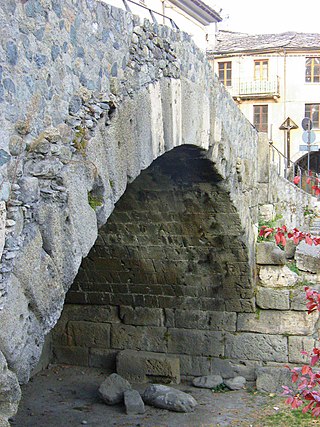
The Pont de Pierre, meaning "Stone Bridge", is a Roman bridge in the Italian city of Aosta in the Aosta Valley. The bridge crossed the Buthier about 600 m (2,000 ft) from the eastern exit of the Roman colony Augusta Praetoria; in later times the torrente changed its course, leaving the ancient bridge today without water.

The Pont Flavien is a Roman bridge across the River Touloubre in Saint-Chamas, Bouches-du-Rhône department, southern France. The single-arch crossing, which was built from limestone, was on a Roman road - the Via Julia Augusta - between Placentia, Italy and Arles. It is the only surviving example of a Roman bridge bounded by triumphal arches from the Augustan period, although similar bridges probably existed elsewhere, as indicated by portrayals on coins of the late 1st century BC.

Imperia is a coastal city and comune in the region of Liguria, Italy. It is the capital of the Province of Imperia, and historically it was capital of the Intemelia district of Liguria. Benito Mussolini created the city of Imperia on 21 October 1923 by combining Porto Maurizio and Oneglia, as well as the surrounding village communes of Piani, Caramagna Ligure, Castelvecchio di Santa Maria Maggiore, Borgo Sant'Agata, Costa d'Oneglia, Poggi, Torrazza, Moltedo and Montegrazie.

Monte Monega is a 1,882-metre (6,175 ft) mountain of the Ligurian Alps, in Italy.

Strada statale 1 Via Aurelia it is one of the most important state highways in Italy and derives from an ancient consular road, the Via Aurelia. It connects Rome with France following the coast of Tyrrhenian Sea and Ligurian Sea and touching nine provincial capitals as well as important tourist locations.




















